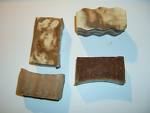America’s love affair with red meat: From farm to table to tallow
“Any of us would kill a cow, rather than not have beef” – Samuel Johnson, English writer. America has a years-long love affair with red meat. From the early years of the American colonization to the present, beef has been one of the top five food items consumed by Americans. As far as statistics goes, since 1910, Americans have been eating an average of about 60 pounds of beef yearly. A recent 1997 study illustrates that an average American consumes about 64 pounds of beef and beef-related items. By all theories and studies, beef stands only next to Turkey and Chicken when it comes to food on table.

The American cowman and beef: Beef has a pretty short history in America, compared to the Middle East and other countries. However, the association between the Americans and bovine meat has been an intimate culinary experience from the beginning. Though domestication of cattle began as early as 6500 B.C., Americans woke up to the cattle revolution only around 1870. During this period, cattle cars and refrigerated cars were introduced in railroads to make distribution of beef easier and simpler. From then on, beef became popular in the country and was used for a variety of things – in soap making, candle making, industrial applications, leather business, cooking and a variety of delicacies. The beef industry grew by leaps and bounds so much so that the USDA estimates that the industry records at least 1% growth every year.
The image of the American cowman needs special mention. In a country of red meat lovers, the American cowman represented a happy and peaceful image of a man with an idyllic farmland full of money-worth cattle.
From farm to table: It can be remembered that only recently beef has met with bad rap owing to its high content of saturated fats. Earlier, it was only beef and beef all over. McDonald’s cooked its French Fries with tallow made from beef and the favorite American hamburger had beef as its primary ingredient. Beef is used as suet in bird feed, in cooking (in making puddings) and other things.
Before we proceed further, what exactly is beef? Beef is meat from full-grown cattle about 2 years old. A live good steer weighs about 1000 pounds, while a calf weighs about 700 pounds. While beef is red in color (that is why the name ‘red meat’), baby beef or calf beef is light red in color. There are at least 50 breeds of beef of which the major breeds are Angus, Hereford, Charlois and Brahman. It is mandatory that cattle raised by farmers should be inspected by the U.S. food authorities. However, grading of cattle (for beef produce) is not mandatory. The top USDA-graded beef sold at retail level are Prime, Choice and Select. Marbling (white flecks within the beef fat) determines the quality of beef. Cuts of beef also vary depending on from where it is extracted – chuck, loin, rib and round cuts are the popular ones. Suet is raw beef fat present around the loin and kidney regions of beef.
From table to tallow: Tallow is rendered form of beef suet. As mentioned earlier, suet is raw beef fat freshly cut from kidneys and loins. Suet is different from meat from other parts of the cow and hence, has special value. When rendered (by industrial or homemade process), suet is cleansed of impurities and meaty things to become tallow. Beef tallow is the result of melting suet and then, cooling it to separate it from impurities.
Tallow has a variety of uses – it is an important ingredient in soap making; it can be used in candle-making; it can be used as a harder cooking oil; it can be used as pet food and recently tallow has found a special role as feedstock for biodiesel production. Beef tallow is solid at room temperature as it has a high smoke point. Owing to its high cloud point, it is used for deep frying of food stuff. Tallow from grass fed beef has high ratio of conjugated linoleic acid (CLA) which has effective anti-cancer properties. Though beef has a high degree of saturated fats, there are studies that prove that humans need at least 50% saturated fats to keep the heart hale and healthy. Considering all these and the increasing demands, it can be said that beef is dear to millions of Americans.








